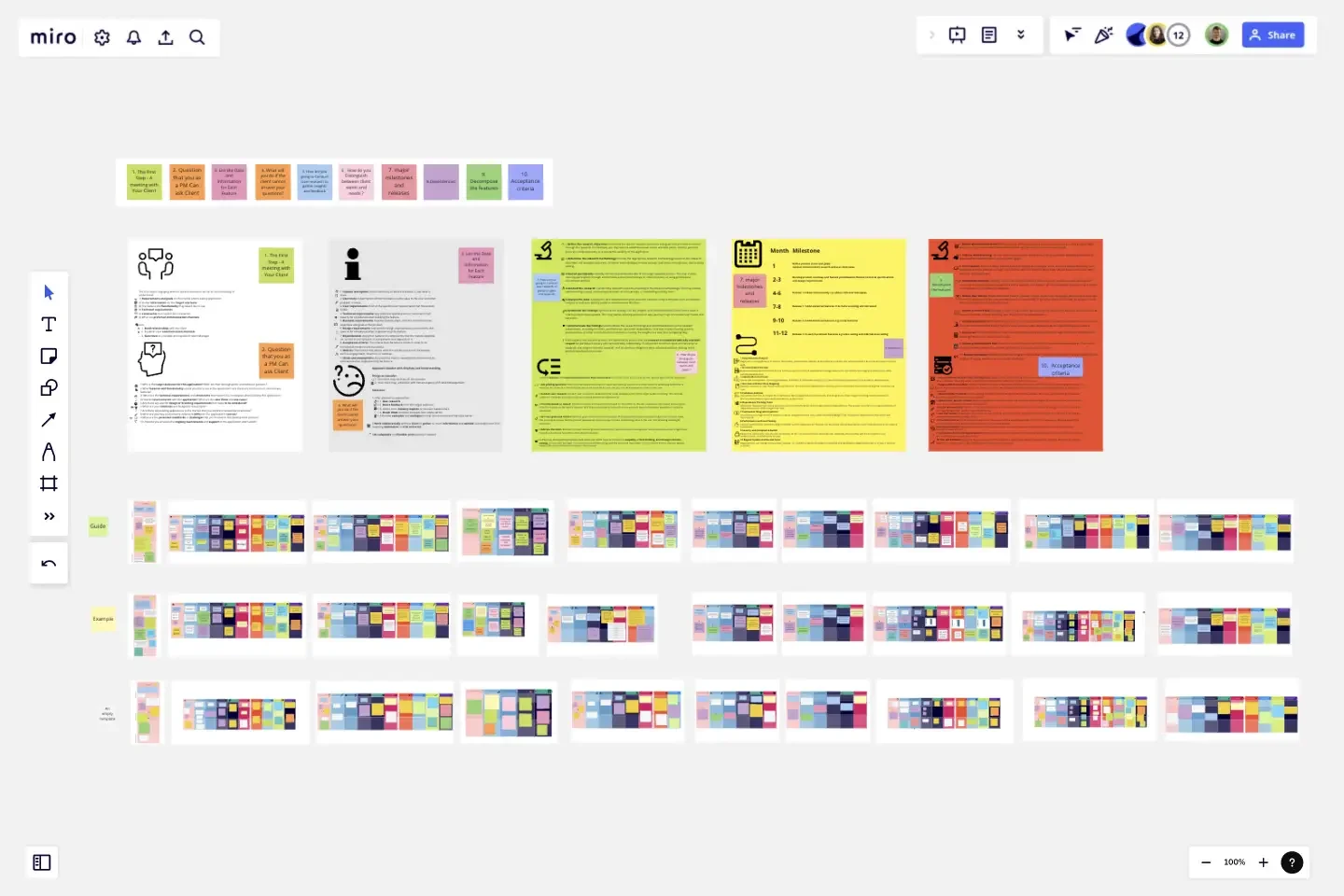Product Management - Product Flow
Streamline product development processes using Product Management - Product Flow template. Visualize stages, tasks, and dependencies for improved workflow.
Engaging with a Client
Purpose: Outline the initial approach to client engagement.
Content: Best practices for first meetings, communication strategies, and establishing rapport.
Questions for the Client
Purpose: Identify critical questions to understand the client's vision and requirements.
Content: Open-ended questions focusing on the client's goals, target audience, expected features, budget, and timeline.
Data Collection for Each Feature
Purpose: Specify the type of data needed for understanding each feature.
Content: Data types like user demographics, market analysis, and technical requirements for the calling and messaging features.
Information Collection for Each Feature
Purpose: Elaborate on the detailed information required for each feature.
Content: API integrations, hardware compatibility, and user interface requirements.
Handling Non-responsive Clients
Purpose: Strategies for proceeding when the client is unresponsive or unclear.
Content: Using industry benchmarks alternative research methods, reaching out to stakeholders.
Conducting User Research
Purpose: Detailing the approach for gathering user insights.
Content: Methods like surveys, interviews, focus groups, user personas, and usage scenarios.
Distinguishing Client Wants vs Needs
Purpose: Framework for identifying and prioritizing client requests.
Content: Techniques to differentiate between essential features and desirable additions, balancing business goals and user needs.
High-Level Timeline
Purpose: Outlining significant milestones and releases over 12 months.
Content: Gantt chart or timeline showing phases like planning, development, testing, launch, and post-launch support.
Top 10 Features with Dependencies
Purpose: Identify key features and their dependencies or constraints.
Content: Detailed list of features with associated technical, resource, or time dependencies.
Decomposing Features
Purpose: Break down each feature into manageable components.
Content: For each feature, list sub-features, tasks, and responsible teams or individuals.
Acceptance Criteria for a User Story
Purpose: Define clear criteria for evaluating whether a user story is complete.
Content: Specific, measurable criteria for one user story, demonstrating what success looks like for that feature.
This template was created by Mark V. Smetanin.
Get started with this template right now.
SMART Goals Template
Works best for:
Prioritization, Strategic Planning, Project Management
Setting goals can be encouraging, but can also be overwhelming. It can be hard to conceptualize every step you need to take to achieve a goal, which makes it easy to set goals that are too broad or too much of a stretch. SMART is a framework that allows you to establish goals in a way that sets you up for success. SMART stands for Specific, Measurable, Attainable, Relevant, and Timely. If you keep these attributes in mind whenever you set goals, then you’ll ensure your objectives are clear and reachable. Your team can use the SMART model anytime you want to set goals. You can also use SMART whenever you want to reevaluate and refine those goals.
Product Roadmap by Mark V. Smetanin
Works best for:
Product Management, Roadmap
Learn to craft effective product plans with the How to Create Product Roadmap by Mark V. Smetanin. This template guides you through outlining key milestones, setting priorities, and visualizing your product journey. Use it to align your team, maintain focus, and achieve strategic goals. Ideal for product managers and teams looking for a structured approach to product development and clear communication with stakeholders.
Service Blueprint by Hyperact
Works best for:
Research & Design
The Service Blueprint template is perfect for visualizing the orchestration of service components. It maps out frontstage and backstage elements, helping you analyze and enhance customer experiences. Use this template to align teams, identify pain points, and streamline processes, ensuring a seamless service delivery. It's ideal for creating a shared understanding of service dynamics among stakeholders and collaborators.
Product tone of voice
Works best for:
Product Management, Planning
The Tone of Voice Workshop template helps product teams define and align on brand tone and messaging. By facilitating collaborative workshops, exploring brand personality traits, and defining tone guidelines, this template ensures consistent and impactful communication. With sections for identifying target audience personas, articulating brand values, and crafting messaging principles, it enables teams to create authentic and compelling brand voices. This template serves as a foundation for building strong brand identities and resonating with customers across all touchpoints.
The Lightning Product Audit
Works best for:
Product Management, Planning
The Lightning Product Audit template streamlines product evaluation processes with a comprehensive framework. By assessing key areas such as market fit, user experience, and feature performance, this template enables teams to identify strengths, weaknesses, and areas for improvement swiftly. With sections for conducting SWOT analysis, user feedback review, and competitive benchmarking, it facilitates data-driven decision-making and prioritization. This template serves as a catalyst for refining product strategies and driving continuous improvement.
Conversion Funnel Backlog Template
Works best for:
Decision Making, Product Management, Prioritization
If you’re working on a product that has clear conversions, then it can help to structure your backlog around the conversion funnel to make sure you’re reaching your audience. Creating a conversion funnel backlog brings together information around potential pain-points in your funnel and opportunities for growth. Once you’ve identified that information, it becomes easier to prioritize. You and your team can use the conversion funnel backlog to focus on conversion, retention, and referral, or to tweak your workflow in more mature products.
